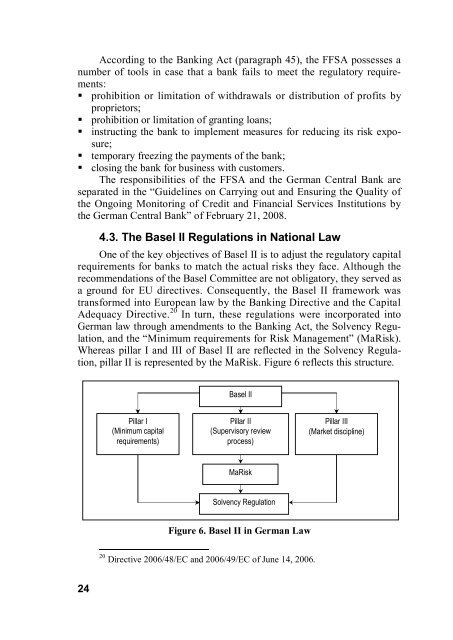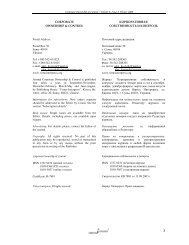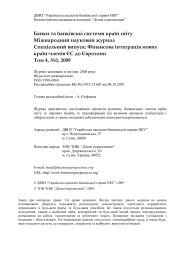- Page 1 and 2: 0/@39 77. =?
- Page 3 and 4: 1
- Page 5 and 6: II. Sadvokasova K.G FEATURES OF ORG
- Page 7 and 8: 7;A?
- Page 9 and 10: The adoption of the Capital Accord
- Page 11 and 12: We express our gratitude to our col
- Page 13 and 14: In order to create a legal basis fo
- Page 15 and 16: HypoVereinsbank (HVB), and Postbank
- Page 17 and 18: The savings banks pillar of the Ger
- Page 19 and 20: Number of banks 3500 3000 2500 2000
- Page 21 and 22: However, the commercial banks secto
- Page 23: 4.2. Supervisory Authorities Wherea
- Page 27 and 28: The MaRisk contains comprehensive r
- Page 29 and 30: Approach in 2008. Therefore, only a
- Page 31 and 32: 5.2.1. Receiver Operating Character
- Page 33 and 34: 5.2.3. Stochastic Tendency Stochast
- Page 35 and 36: anks applying the LDA use the Poiss
- Page 37 and 38: 7. Deutsche Bundesbank (2007): The
- Page 39 and 40: There are several reasons why Hong
- Page 41 and 42: comply with its regulations. The SF
- Page 43 and 44: eview of an AI’s operations. The
- Page 45 and 46: isk management. In addition, the HK
- Page 47 and 48: data reveal deteriorated asset qual
- Page 49 and 50: the saving deposit rate offered by
- Page 51 and 52: Although to Lehman Brothers and AIG
- Page 53 and 54: out warnings beforehand. Similarly,
- Page 55 and 56: in the implementation of monetary a
- Page 57 and 58: (see Jao 1997 for details). Hong Ko
- Page 59 and 60: 9. (1999) “Free Banking and Infor
- Page 61 and 62: Appendix 1 Performance of the Hong
- Page 63 and 64: Timotej Jagric Professor Department
- Page 65 and 66: was in the following period dominat
- Page 67 and 68: gazette of RS, No. 131/06) allowed
- Page 69 and 70: In Slovenia the loan-to-value ratio
- Page 71 and 72: lending for needs not related to th
- Page 73 and 74: Banking supervisors examines whethe
- Page 75 and 76:
Slovenian financial system) and lea
- Page 77 and 78:
Ownership structure of the Slovenia
- Page 79 and 80:
implementation of the IRB approach
- Page 81 and 82:
and implement them. Besides direct
- Page 83 and 84:
Banka Slovenije recommended that ba
- Page 85 and 86:
domestic enterprises, and would hel
- Page 87 and 88:
Assoc. Prof. Dr. Okan Veli Şafakli
- Page 89 and 90:
’% 16/?/1A3?7@A71@ /;2 :/7; 7;271
- Page 91 and 92:
When analyzed at current prices, fr
- Page 93 and 94:
Sectoral Distribution of Working Po
- Page 95 and 96:
(% A63 ?35B9/A
- Page 97 and 98:
)% /@@3@@:3;A
- Page 99 and 100:
G.S. Seytkasimov The rector of the
- Page 101 and 102:
were instrumental in creating the c
- Page 103 and 104:
The operations carried out by these
- Page 105 and 106:
The main characteristics of the ban
- Page 107 and 108:
in the sphere of accounting and rep
- Page 109 and 110:
tasks were determined with orientat
- Page 111 and 112:
K.G. Sadvokasova Cand.Econ.Sci., th
- Page 113 and 114:
of RK, which it executed till 2004,
- Page 115 and 116:
Track record of the changes in the
- Page 117 and 118:
But since 2004 with the creation of
- Page 119 and 120:
A.A. Mycina The Doctor of Economics
- Page 121 and 122:
Data about the banks of the second
- Page 123 and 124:
Years Indicators of banks of the se
- Page 125 and 126:
cent in 2002 to 31,3 per cent (3,5
- Page 127 and 128:
increased nearly twofold - from 521
- Page 129 and 130:
The indicators of the ownership cap
- Page 131 and 132:
change in the following 2002: the r
- Page 133 and 134:
Table 22 continued Figures in billi
- Page 135 and 136:
The instability on the global marke
- Page 137 and 138:
K.G. Sadvokasova Cand.Econ.Sci., th
- Page 139 and 140:
elationship that is affiliated as a
- Page 141 and 142:
To strengthen control over the acti
- Page 143 and 144:
K.G. Sadvokasova Cand. Econ. Sci.,
- Page 145 and 146:
In the IMF document “Quality of f
- Page 147 and 148:
1
- Page 149 and 150:
Doc. Ing. Frantisek Pavelka CSc. He
- Page 151 and 152:
slight overvaluation of their quali
- Page 153 and 154:
f) the bank must have a programme o
- Page 155 and 156:
From that by approach: BIA 0,92 %,
- Page 157 and 158:
2002, banks are also required to ha
- Page 159 and 160:
anks (judging by ballansovoy cost m
- Page 161 and 162:
• UniCredit Bank CR, a.s.; • Ko
- Page 163 and 164:
although a limited degree. From Boh
- Page 165 and 166:
Initially the new century for the b
- Page 167 and 168:
Table 1 Some indicators of banking
- Page 169 and 170:
opinion of supervisors, as well as
- Page 171 and 172:
II posts. Market discipline means t
- Page 173 and 174:
To determine the credit risk is the
- Page 175 and 176:
The borrower who does not have an e
- Page 177 and 178:
• financial institutions - primar
- Page 179 and 180:
Table 4 Distribution of commercial
- Page 181 and 182:
2.4. Evaluation results of the new
- Page 183 and 184:
once a year to 30 June on the inter
- Page 185 and 186:
Ing.Oldřich Knaifl CSc. Head of Fi
- Page 187 and 188:
Internal Ratings-Based Approach to
- Page 189 and 190:
Capital Requirement + Expected Loss
- Page 191 and 192:
A.O. Yepiphanov Doctor of Economics
- Page 193 and 194:
continued to work with the status o
- Page 195 and 196:
Among the peculiarities of banking
- Page 197 and 198:
Table 1 The main indexes of banking
- Page 199 and 200:
Speaking about the correlation of d
- Page 201 and 202:
insuring of liquidity and profitabi
- Page 203 and 204:
In 2008 under the influence of the
- Page 205 and 206:
Index Race of core capital increase
- Page 207 and 208:
The indexes of foreign capital pres
- Page 209 and 210:
over during the financial crisis, f
- Page 211 and 212:
An important moment in the developm
- Page 213 and 214:
• the third component-basis “Ma
- Page 215 and 216:
215
- Page 217 and 218:
According to the data from the tabl
- Page 219 and 220:
The requirements as to banking repo
- Page 221 and 222:
From the point of view of formation
- Page 223 and 224:
Let’s consider in details the pec
- Page 225 and 226:
of Ukraine” [20]. This document s
- Page 227 and 228:
Table 12 continued № Title of the
- Page 229 and 230:
9. Поченчук Г.М. Проб
- Page 231 and 232:
Type of the financial reporting Qua
- Page 233 and 234:
Appendix 3 The general list of note
- Page 235 and 236:
Appendix 4 Assessment of interest r
- Page 237 and 238:
№ № of reporting form 15 618 16
- Page 239 and 240:
№ of the table 1 2 Appendix 7 Inf











